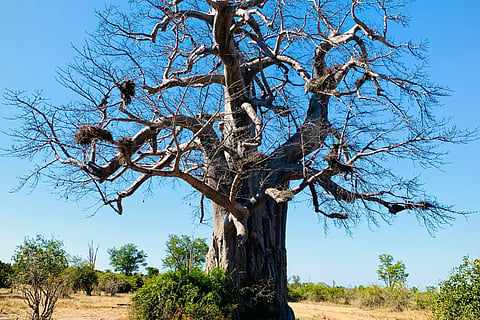Elegy for a Boab tree
Let’s begin with a small attempt to understand one of Nature’s marvels. Looking like a misfit, the boab tree, also known as bottle tree or upside-down tree due to its freaky swollen trunk, is a venerable living thing that can, if it had a voice, narrate the passing of history. Perhaps dating back to before the Continental Shift, the boab is a tree that grows both in Africa and in parts of Australia. Inscriptions made on the bark of the tree by unknown hands, have proved to be more than a century old. Some specimens of the African boab are estimated to live for almost 2,000 years.
Anyone who has visited the historic town of Mandu in Madhya Pradesh will know that the streets are still lined with boab trees, that were imported from Africa and planted there, because they took a king’s fancy. In the absence of tamarind trees in the region, locals use the paste of the sour fruit instead.
By some quirk of chance three boab trees have stood like minor minarets in different places along the busy roads of Mumbai city too. They stood unnoticed, curious characters watching the city grow beyond its limits towards self-destruction. In a city, once full of a huge variety of trees, some flowering, some fruiting, some ornamental and all home to birds and small animals, the boabs added their bit to Nature’s effort.
Perhaps no one knew it, but if left alone, they would still be standing, impassive, when the 21st century gives way to the 22nd.
But the town planners, those men with degrees and electric saws and power-driven machines and an army of workmen at their command, knew little of the history of the boab. They knew they had to fulfil the vision of a new Mumbai, where people could fly in their cars over elevated roadways, or in noiseless metros and could move from one end of the linear city to the other without hindrance.
They knew little, and cared less about the trees that shared space with the bustling populace of the city. The trees lived lives as busy as any human; providing valuable oxygen, nurturing insects and birds, butterflies and bees that all had a role to play in keeping the city functioning. Having no voice, the trees did their work silently, as they had been doing for centuries; and an entire ecosystem thrived parallel to that.
To the men with machines and purpose, the trees were but a hurdle. A useless impediment in the way of the city’s progress. Except for a few street children who waited for the fruiting trees to bear their bounty, no one cared about the fruit, or the bouquets the branches sent out. Who had the time?
So the boab tree, witness to generations of Indians, Bombaywallahs, Mumbaikars… was removed. Swiftly, hopefully painlessly.
In another county, the tree would have had placards placed in front of it, a curiosity that would make people stop, read and exclaim about this strange green citizen of African descent. Here, it lived and died, unnoticed. Doing its duty quietly while it lived, dying without a murmur, when it was cut down. And we were once a people who worshipped trees.
Sathya Saran
Author & Consulting Editor, Penguin Random House
saran.sathya@gmail.com

